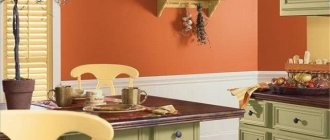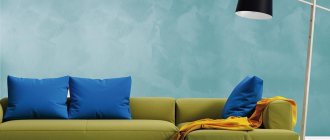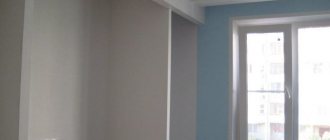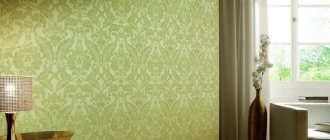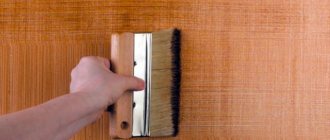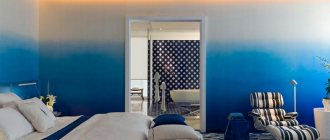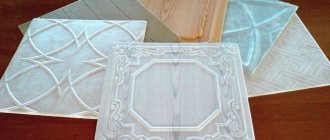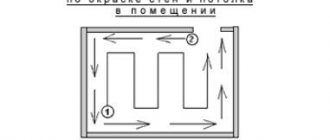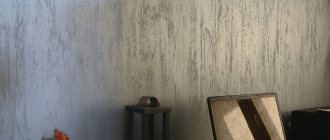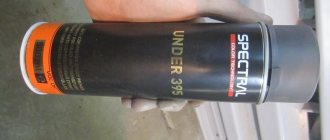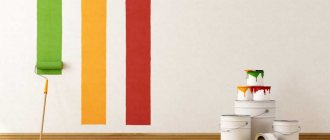Modern trends in interior design have again returned to the leading position the painting of walls with various types of paints. This is due, first of all, to the growing popularity of paintable wallpaper. In this vein, this type of wall decoration such as painting has begun to regain its position - it is beautiful, stylish, fits into any interior design style and, at the same time, is not too expensive.
Just a few decades ago, oil paint was used to decorate walls, since manufacturers of paint and varnish products did not offer an alternative. Everything changed with the advent of a line of water-based paints, as a result of which they no longer have equivalent replacements.
For information: water-based paint is a mixture (dispersion) of water with coloring pigments and tiny insoluble particles of polymers that are suspended. After the solvent (water) dries, a thin but very durable polymer film remains on the painted surface, which gives the painted materials an attractive appearance.
In such a kitchen, the appetite grows not only from the aromas of the food, but also from the beautiful interior.
The current situation was the result of many positive qualities of water-based compositions.
Advantages and disadvantages of water-based paint
Water-based paint has both strengths and weaknesses. The advantages include:
- the absence of a sharp unpleasant odor, which is imparted to other types of paint by a solvent, for example, acetone or white spirit;
- rapid dissipation of the damp smell that appears immediately after painting;
- environmentally friendly paint components - absolutely harmless to humans and the environment;
- Possibility of application to all types of wall materials;
- a fairly simple paint application technology, which makes it possible to paint walls with water-based paint yourself;
- Manufacturability: simply diluted, stirred, tinted and applied;
- variability of tinting with pigments - the paint can be given any color and shade;
- the ability to be easily washed off from tools, hands, clothing and the floor at the end of work;
- accessibility to the bulk of the population at a price;
- fast drying process;
- ability to fit into any interior and style;
- resistance to aggressive chemicals, primarily alkalis;
- vapor permeability allows the walls to breathe.
The disadvantages include:
- inability to withstand sub-zero temperatures - it cracks, and therefore cannot be used in unheated rooms (dachas, country houses, where visits are irregular in winter);
- significant labor costs in preparing walls for painting;
- susceptibility to colonization by fungus and mold, which multiply very actively in damp or poorly heated rooms.
The best gold paints - manufacturers
Gold paints are produced by different companies. You can buy them at any hardware store by choosing the shade.
Aerosol coatings
Among the best manufacturers of acrylic paints is the American company Rust Oleum with its product Metallic Accents. The mixture contains special substances that give a golden hue to the painted surface. The series includes a wide range of shades: from light gold to dark brown tones. The enamel is compatible with different interior styles. It can be used for walls, furniture and wallpaper.
Other popular brands of spray paints include:
- Champion. Produces paint and varnish materials for various areas of operation. The catalog contains 25 types of sprays, including aerosol models for gutters and roofs.
- BeLife. Chinese manufacturer of aerosol coatings, which is part of the SANVO group. The products are inexpensive and are available in 10 modifications.
- Leader. A popular supplier of aerosol paint with facilities in Ukraine. To manufacture the product, high-quality German raw materials from BAYER are used.
The composition of the aerosol paint, developed by the German manufacturer, fully meets the needs of consumers.
Paints for decoration
Olki materials are popular among artists. This brand produces a powder mixture based on natural gold leaf. It has good coverage, is inexpensive and dries quickly.
Pebeo products, which appeared on the market back in 1919, are no less in demand.
From domestic ones with their “Master Class” series, which is much cheaper than foreign analogues.
Forging compounds
A popular supplier of forging compounds is the German brand Weigel Schmidt GmbH. The WS-Plast series has increased resistance to corrosion. Such paints extend the life of metal products and at the same time are consumed quite slowly. For 1 sq. m of surface requires 125 g of material.
The main part of the brand's assortment is occupied by dyes with a graphite effect. These include emerald and white enamels, as well as models with a red tint.
The WS-Patina series with a golden patina effect provides an unusual bronze shine on the metal and interesting relief accents. This treatment will be much cheaper than coating objects with gold or silver.
For painting metal surfaces, choose budget gilding from WS-Patina.
Hammerite hammer paints are made in Britain. They contain both a mixture for painting and a primer solution.
The substance is applied to the area with corrosion without prior preparation. The product takes 1.5 hours to dry. It takes 14 days for final hardening.
Verified domestic suppliers include: Novax solution is made on the basis of enamel with anti-corrosion components. It is a 2-component composition for use in aggressive environments.
Wood paints
Tikkurila products are considered the flagship in the market of paints and varnishes.
The brand produces compounds for wood processing, including the popular Euro Power 7 series.
You can purchase this mixture for 320 rubles.
Lovers of golden color will love the paint from Tikkurila.
Wood paint from the Kolorit company enjoys a positive reputation in the middle price segment.
The ranking of the best paint suppliers includes the Sadolin brand. It belongs to the concern of the same name with its head office in Finland. The company produces a wide range of coloring compounds with increased heat-resistant properties.
Wood patina and mixtures with a gouache effect are in particular demand.
Powder paints
Duxone products are popular due to their high quality, proven recipes and low cost. In the production process of each series of coatings, modern technologies and materials are used.
The next most popular brand is Asonsisi. Since 1920, the brand has been producing high-quality coloring compositions, occupying leading positions in popularity ratings.
Paint from Akzo Nobel is no less in demand. The Dutch company has earned respect due to the variety of series of paints and varnishes, the fast drying of the compositions and the low consumption of the working mixture.
Required materials and tools
Painting walls with water-based paint requires the purchase of the following materials:
- water-based paint (you need to buy one batch - different shades are possible in different containers);
- pigment dyes (if the paint is purchased white) to give the water-based emulsion the desired color and shade;
- primers for painting (Knauf, Ceresit and others).
In addition to materials, you will need the following tools:
- ladder;
- screwdriver (electric drill) with a mixer for stirring paint;
- a set of paint rollers (for paint and primer);
- spray gun or paint brush (5-8 cm) for painting corners and places near the baseboard;
- small brush for color correction in hard-to-reach places;
- crepe (painting) tape;
- cuvette for primer and paint;
- plastic film to protect furniture and floors from paint splashes or cardboard (old newspapers);
- construction tape for fastening polyethylene.
Which paint to choose
The quality of the repair depends on many factors, but the determining factor has always been the choice of finishing material, which is carried out according to specific criteria. In relation to water emulsion it is:
- paint color;
- degree of gloss;
- hygroscopicity;
- possibility of care.
Color
Water emulsion can have up to 200 colors and shades. It is unrealistic to produce paint with such color variety. Therefore, manufacturers took a more convenient path: they made white the base color, and at the same time launched tinting dyes for sale.
By mixing colors with white paint in various proportions, you can get complex colors that are not found on sale. In addition, by changing the proportions of various pigments, you can achieve different color intensities, moving from a rich tone to a restrained one, which in the language of designers is called the gradation effect.
This is what the color spectrum of water-based paint looks like.
You can mix paint with pigments at the seller (all major retailers provide this service) or at home. Tinting a house allows you to see how the walls will look after painting, since the color of the diluted paint does not match the color of the dried water-based emulsion.
Here a little trick comes to the rescue: the diluted paint is applied to the wall in a small area. After 2-3 hours you can see how the painted surface will look. If necessary, you can adjust the color by adding dyes to the paint container. Below is a tip on how to get some colors using several tints.
By mixing different pigments, you can get up to 200 colors and shades.
Gloss level
The appearance of the surface and the visual perception of the room depend not only on the chosen color and shade, but also on the degree of gloss. He can be:
- deeply matte - it looks impressive and respectable, but even a one-time cleaning with a damp cloth can disrupt the texture at the micro level (in plain language - you can’t rub, as shiny spots may appear);
- matte (the room visually increases in size, but on such a surface the slightest staining defects are clearly visible, it is difficult to wash with a damp cloth or napkin);
- semi-matte - maximum hides mistakes in preparing the wall for painting, is resistant to abrasion (washes well);
- glossy (emphasizes flaws, but maintenance is not a problem);
- semi-gloss - washes well.
The best option is to buy semi-matte or semi-gloss paint.
Hygroscopicity
There are always rooms in the apartment with different humidity levels:
- dry (children's room, bedroom, living room);
- with high humidity (hallway);
- with a high level of humidity (bathroom, toilet, kitchen).
For rooms with excess moisture in the air, moisture-resistant types of paints are produced. This point should be taken into account when purchasing a water-based emulsion.
Ease of care
Produced water-based paints can be:
- unsuitable for wet cleaning (clean only with a vacuum cleaner or dry cloth);
- washable (can be cleaned with a wet cloth or sponge using detergents);
- indelible - wash only with clean water.
Affects the final finishing result and the type of water-based paint. She may be:
Mineral. Mineral water-based paint is a budget type of paint, since it is based on cheap cement or lime. Applies well to concrete, brick, plasterboard, wood. However, the short service life (fades out quickly), high hygroscopicity and the impossibility of wet care have led to a drop in sales.
Acrylic. This is the most popular water-based paint. It has a long service life, low consumption per 1 m2 of wall, the ability to heal microcracks up to 1 mm wide, and easy maintenance. And most importantly - the most optimal combination of price and quality.
Semi-matte acrylic water-based emulsion, when applied in several layers, at least 3, perfectly hides minor surface defects due to the presence of acrylic resins, which do not allow the polymer film to deform, repeating all the irregularities on the wall. In addition, painted walls can withstand temperature changes and significant mechanical impacts, preventing the paint layer from breaking.
Disadvantages include low vapor permeability, which negatively affects the quality of paint when finishing poorly dried surfaces.
Silicate. Due to the introduction of potassium liquid glass into the composition, silicate paint forms a thin glass film on the wall after drying. This paint has a number of advantages:
- does not fade until the end of operation;
- serves for a long time - more than 20 years;
- resistant to temperature changes;
- does not burn;
- easy to clean;
- excellent resistance to fungus and mold;
- has a low price.
However, the disadvantages still outweigh:
- poorly tinted;
- there is no plasticity, and therefore all microcracks and other defects are not hidden, but, on the contrary, are emphasized;
- does not withstand high humidity well (you can only paint the living room and bedroom);
- does not adhere to porous and loose materials, as well as wooden walls.
As a result, the editors of the site advise you to refrain from purchasing silicate paints.
Silicone. The latest achievement of manufacturers of paint and varnish products is silicone water-soluble dye. It has no disadvantages, only advantages:
- good vapor permeability while being waterproof;
- high elasticity, which allows the paint layer to heal microcracks;
- resistance to mechanical stress;
- long service life;
- high aesthetic characteristics, etc.
Naturally, high quality corresponds to a high price.
For reference: many experts classify polyvinyl acetate paint materials as water-based paint. They are based on PVA glue, to which plasticizers and dyes are added. In our opinion, this type of paint does not fit into the classical understanding of water-based emulsion, and therefore is not considered in this material.
For clarity, we summarize the main parameters of water-based paints in a table.
| Properties\Types of paints | Mineral | Acrylic | Silicate | Silicone |
| Vapor permeability | low | high | average | high |
| Film strength | high | good | good | good |
| Color fastness | average | good | high | good |
| Fire resistance | No | average | high | average |
| Elasticity | average | high | No | good |
| Resistance to washing off | high | average | high | low |
| Mold resistance | average | low | high | average |
| Color palette | high | good | average | high |
| Hygroscopicity | high | low | No | average |
| Price | low | average | low | high |
These tables confirm preliminary conclusions: silicone dyes are the most effective. But in terms of price/quality ratio, acrylic paints are the leaders.
Calculation of the required amount of paint
When carrying out repair work, it is always unpleasant when the purchased material is not enough. This problem is most acute when purchasing water-based emulsion. After all, after an additional purchase, it is almost impossible to achieve the same shade if the paint is tinted yourself. Therefore, the question of how to calculate the amount of paint for walls needs to be given special attention. The whole process can be divided into III stages.
Stage I. The area of the surface to be painted is determined. To do this, measure the perimeter of the walls and then the height of the ceiling. When multiplying the resulting numbers, the total area of the walls is obtained. Windows and doors are measured. Their area is subtracted from the previously obtained result.
This is approximately how the wall area is calculated.
Stage II. The preliminary amount of paint is determined. To do this, the area to be painted is multiplied by the paint consumption per 1 m2 (always indicated on the packaging), the average value is given in the table and by the number of layers (minimum two).
Table 2. Average consumption of water-based paint per 1 m2.
| Water-based paint | 1 layer, g/m2 | 2 layer, g/m2 |
| Mineral | 340-370 | 200 |
| Acrylic | 250 | 150 |
| Silicate | 400 | 350 |
| Silicone | 300 | 150 |
Stage III. The obtained result is corrected. Let us immediately clarify that the packaging shows the paint consumption for a perfectly smooth surface, which has been primed in advance. Coloring:
- unprimed plastered surface increases consumption up to 10%;
- drywall without putty and primer by 40%;
- wallpaper for painting by 40-45%;
- trellises for painting with a relief surface of up to 70%.
The walls are painted not only with putty, but also with wallpaper for painting.
It also matters what tool you use to apply the paint. When using a roller and spray gun, no further adjustments are made. A paint brush requires an increase in the amount of water-based emulsion by about 5%.
You can save on painting materials by:
- a perfectly flat surface that can be obtained during the preparatory work;
- applying primer to the walls;
- Observe the order of painting: first, paint the corners with a brush, then the wall near the trim and baseboard (it’s still better to remove them). Only after this the rest of the surface is painted with a roller or spray gun. If the order is reversed, 1-2% of the water-based emulsion is lost.
Release forms
Paint is produced in a certain form in order to facilitate certain works. For example, aerosol containers are intended for painting or restoring small elements of paintings and furniture, in order to give things a flair of antiquity. The paint is applied in a thin layer without visible thickening.
The paint is applied in a thin layer without visible thickening.
Paint in a metal can
Gold acrylic paint in a tin is a classic solution that has never been canceled. This composition is more economical, it is enough to cover a large surface, the colors are presented in various shades of gold. The effect of such a coating is reminiscent of painting from antiquity. The coating prevents the formation of corrosion and has a repellent effect.
The effect of such a coating is reminiscent of painting from antiquity.
Spray paint
Golden paint in cans is no less popular in use. Gold spray paint has its advantages:
- Uniform distribution (the composition does not spread).
- Thin layer (fine spraying does not thicken the base coat).
- Versatility (suitable for all types of surfaces).
- Minimum drying time (the composition dries quickly and can withstand temperatures over one hundred degrees).
- Protection (the coating can be used as a protective layer).
When spraying a can of gold paint on a metal surface, the composition is enough for only three square meters. For large areas to be painted, spray paint is not the most practical option.
This form is more convenient for drawing ornaments on small surfaces. Due to the economical spraying of the material, goldenrod dries instantly. The paint does not peel off afterwards. Gold paint in cans does not spread and fills all hard-to-reach, protruding places. When decorating with skillful spraying, it is easy to create any decor.
This form is more convenient for drawing ornaments on small surfaces.
Gold powder or powder
The glitter powder contains tiny gold leaf particles. Due to this, the paint acquires a gilded effect. The dry composition is applied to a dry, flat surface, preferably wood. Golden pollen is pre-dissolved in water. The powder favorably emphasizes the advantages of the coating, dries quickly, and is economical.
Golden pollen is pre-dissolved in water.
The best way to apply water-based emulsion
Painting technology allows the use of 3 types of painting tools:
- brushes;
- roller;
- spray gun.
It takes a long time to paint with a brush, which increases paint consumption. Buying or renting a spray gun is expensive for the family budget. Therefore, there is only one thing left to do: pick up a roller and paint the walls. However, difficulties arise here: which roller is best to paint walls with water-based paint? After all, there are dozens of types and varieties of paint rollers on store shelves.
Which roller is better to choose and how
Rollers are made from several types of materials:
Foam rubber. This is the simplest and cheapest type of paint roller. The low density of the material allows it to absorb a large amount of dye, which, on the one hand, is convenient - there is no need to frequently dip the tool in paint. On the other hand, a large amount of paint on the roller leads to the formation of many microscopic bubbles on the painted surface.
Velor. Among specialists, there is an ambiguous attitude towards such a tool, so it can only be found on sale in specialized retail outlets. The peculiarity is that the dense structure of the velor does not cause splashes and applies the paint evenly. But this coin also has a downside: you have to constantly dip the roller into paint, which for specialists means loss of income.
Fur. Available in natural and faux fur. When purchasing, you can not pay attention to the type of material, since there is practically no difference between them. But you need to look at the length of the pile. Short fibers splash heavily (i.e. abundantly and far) with paint. Long pile tends to come out of the base and also splashes, but not so abundantly. Therefore, the most acceptable option is a fur roller with medium-length pile.
Benefits of gold plating
Acrylic-based gold paints are available in cans, powders or formulations in metal containers. Unlike other types of paints and varnishes, the substance is safe, because does not contain harmful volatile compounds that are dangerous to the body. The paint also quickly adheres to different surfaces and can withstand sudden temperature changes and exposure to high humidity.
The working mixture dries quickly and can be used for various jobs. Acrylic gilding is needed for simple painting, as well as decoration and painting.
The coating prevents the destruction of structures by external factors.
Preparatory work
In the instructions on how to properly paint walls with water-based paint, special attention is paid to preparatory work. The final result largely depends on their quality. During their execution it is necessary:
- empty the room of furniture, cover the floors with film or newspapers;
- remove old finish;
Even with a strong desire, you cannot paint such a wall.
- inspect the walls. If necessary, remove old plaster, seal cracks and crevices;
- treat the walls with primer;
- level the surface using drywall or cement (gypsum) plaster;
- apply a primer under the putty;
- putty the walls using a technology that involves applying the last layer of finishing (fine) putty. If finishing putty was not purchased, and the walls were sanded using the starting composition of the putty solution, it is advisable to prime the surface.
It's a pleasure to work on putty walls.
Attention: the detailed process of preparing walls for painting can be seen in the work “Aligning walls for painting.”
How and what to prime
It is not at all necessary to prime the walls for water-based paint. Apart from increased consumption of materials, no other serious consequences are observed. This, by the way, is what apartment owners do in most cases when carrying out renovations. However, the high price of paint, especially silicone, forces the walls to be primed - the technological operation is justified by financial savings.
We should not forget that the primer allows:
- improve adhesion between the wall and the paintwork;
- strengthen the surface to be painted;
- protect walls from fungus and mold.
Of the variety of primers, it is best to use the acrylic primer of the famous brands Knauf or Ceresit. Russian primers are not much worse: “Prospectors”, “Tex” and others (price per 1 liter - 30-100 rubles).
The primer is applied with a brush in one pass, with a roller in two.
Priming the walls makes the job easier and saves paint.
It is equally effective to use homemade soil for walls. To do this, the paint is diluted with water in a ratio of 1:2, where 1 part is paint, 2 parts water. This composition, when painted in two layers, significantly improves the quality of painting.
Application method
The ornament is applied with a roller, brush, spray gun or aerosol, depending on the amount of work. Before painting, it is recommended to wash the surface of the walls with soap and water, dry and degrease. After which they are pre-sanded with fine sandpaper to eliminate irregularities and better adhesion to the paint. Use masking tape to cover areas where paint should not get in.
The next stage is priming with specially developed compounds. Some manufacturers have taken into account all the nuances and released a line of gold paints complete with base and top coats. It is better to apply the gold composition in two thin layers. External work in the open air is carried out in calm weather.
Aerosols should never be sprayed near fire sources. When working, you should use protective equipment for the respiratory system, eyes, hands and hair.
It is better to apply the gold composition in two thin layers.
Painting instructions
How to paint walls with water-based paint? There is nothing difficult to understand or implement. Even a beginner can do the job. You just need to follow the rules:
- Painting is carried out using a completely dry primer or putty.
- The second and subsequent layers of paint are applied to completely dry previous layers (from 2 to 12 hours).
- Under sunlight, wet paint changes color. Therefore, work must be carried out either in the evening or with the windows covered with plastic film.
- Drafts contribute to the appearance of stains due to uneven drying of the applied paint. The same situation is observed when walls are forced to be heated with a heat gun or electric heating devices.
- A coat of paint should be applied to one wall within 15-20 minutes, which eliminates breaks and smoke breaks.
- According to technology, each layer of paint requires a new roller. In practice, they do it a little differently: thoroughly wash the used roller and then dry it. In terms of the quality of paint application, a previously used roller is not inferior to a new one.
- When changing the consistency of paint or tinting it, special attention must be paid to the periphery. It is on the sides of the container that poorly mixed paint is most often found, which is especially unacceptable when coloring pigments are introduced into its composition.
- The corners and narrow sections of the wall adjacent to the ceiling and floor are always painted first with a brush.
- If the trims and baseboards cannot be dismantled, they must be sealed with masking tape.
- For the first layer, the paint is diluted a little more.
Features of choice
You need to buy gold paint taking into account the type of work you plan to do. At the same time, before purchasing, it is worth determining what influences the object to be painted will be exposed to.
For decoration
To paint decorative items, choose aerosols and sprays with a chrome plating effect. The compositions are easy to apply and can be used to process objects with non-standard shapes and designs. With the help of such products, you can create an original design, including imitation of antiquity or obtaining a matte shine.
Sprays with chrome effect and aerosols are recommended for decorating products in the interior.
If you need to paint an expensive item or jewelry, it is better to use art acrylic. This variety contains gold leaf with an original and bright effect.
For wall covering
Surfaces are treated using acrylic mixtures. Due to their versatility, the materials are used to cover concrete and other types of walls. The paint is not afraid of exposure to negative factors, and varieties such as enamel are sold at relatively low prices.
When painting wall structures, it is customary to combine several types of paints and varnishes. Subsequent layers are distributed only after the previous ones have dried. But it is recommended to apply acrylic and primer as a base coat.
For painting wood
Wooden products are treated with acrylic substances. Before carrying out the procedure, a primer or other mixture that prevents rotting should be spread over the surface.
If you need to cover a decorative frame, it is better to use an artistic acrylic mixture.
For metal processing
Such items can be painted with acrylic or blacksmith's mixture. The first option is in demand when processing products with a simple design. The second is suitable for designing more complex elements.
To paint metal parts of the surroundings, it is recommended to use acrylic paint.
Preparing the Paint
When opening a container of paint, its consistency is almost always much thicker than required for the job. Therefore, the paint is thoroughly mixed, adding water in small portions so as not to dilute more than necessary.
This operation is most conveniently performed with a screwdriver with a mixer attachment. If you don’t have a power tool, you can stir with any object, but it takes a long time and the quality is a little worse.
The easiest and fastest way to stir paint is to use a screwdriver with a mixing attachment.
If the wall design is creative and involves the surface shimmering under streams of light, it is at this moment that various sparkles are added to the paint. But such ideas come to owners quite rarely.
If small grains appear on the surface of the paint in the funnel, the water-based emulsion must be filtered through 3 layers of gauze.
Paint tinting
Giving paint a certain color and tone at home is carried out according to the following algorithm:
- The water emulsion is poured into a large container (usually a 10 liter bucket) so that it is enough to paint the walls in one room, since it is almost impossible to obtain the same color and shade again. As an exception, for a wall with a window you can make the paint a little lighter, as a result of which the room will visually appear larger;
- adding water in small portions, the paint is brought to the required consistency while mixing;
- Tinting pigments are added to the water-based composition, after which the paint is thoroughly mixed. If necessary, the resulting color is adjusted: new pigments are added or the number of those already added is increased. Everything gets mixed up again;
To see the final result you need to paint a small section of the wall.
- With the resulting paint, a small section of the wall is painted so that after about 2 hours you can see the real color scheme of the interior. If the result is not satisfactory, the tinting process continues.
Gold paint, what are they?
Liquid gold plating is a frequent visitor to hardware stores. There are oil, alkyd, water-dispersion, acrylic compositions. They differ in composition and scope of application. Liquid gold is applied to all surfaces:
- Metal (fences, enclosures, gates, handicrafts);
- Wood (picture frames, room decor);
- Glass (glass products, interior design);
- Plaster (figurines, stucco, gift items);
- Wallpaper (ornament on the walls);
- Concrete (internal and external types of work);
- Stone;
- Enamel.
The paint is produced in spray bottles, a classic can and in the form of a dry powder. The composition and color palette are developed taking into account the characteristics of the surfaces to be painted.
Liquid gold is applied to all surfaces.
Classification of compositions
Gold-plated dyes differ from each other. Each composition is suitable for a specific type of work. Water mixtures are intended for interior decoration of premises. Oil and alkyd gold plating is applied to a metal surface. Chrome compositions are preferred by creators of creative designs. The formula with chrome is used for decorating and restoring souvenirs, dishes, plaster, and interior decoration. Even antique things begin to shine expensively. The chrome effect gives any metal object a certain meaning.
Dry powder substances must be diluted with water. The mixture is easy to apply to the surface; the preferred base is wood. Gold paint is a favorite material of icon painters, artists, and furniture restorers.
Dry powder substances must be diluted with water.
A separate group is usually called blacksmithing in accordance with the area of their application. Due to the unusual coloring effect, golden metal paint is used for external entrance areas. Cemetery fences, gates, bas-reliefs. Some compositions can create the effect of old metal or a broken surface. So-called hammer mixtures give the surface a crumpled effect, like after being hit by a hammer. Experienced professionals prefer the technique of mixing different types of gold paints on metal, which allows them to apply several effects simultaneously.
The basic rule is the principle of the golden mean. Only moderate inclusions of gilding give an aesthetic appearance, without unnecessary pomp.
Hammer mixtures give the surface a crumpled effect like after being hit by a hammer.
Painting technique
You can paint walls with a brush, roller or spray gun. There are technologies developed over the years for this.
Painting with a brush
For those nostalgic for the good old days, we recommend painting the walls with a brush. But we warn you right away. This takes a long time, is not of very good quality, and the paint consumption is a little higher (some will end up on the floor in the form of drops, some will remain on the wall in a thicker layer of paint).
Before starting work, the brushes (a large flywheel and a small corrective one will be required) are soaked in water so that no bristles remain on the wall during the work.
The paint is poured into a cuvette if the packaging is large, or remains in the jar. In the latter case, the water emulsion is stirred regularly, approximately every half hour, to maintain a homogeneous composition.
The brush is dipped about 1/3 of the way, after which excess paint is removed with light blows against the wall of the jar or tray. The coloring starts from the upper left corner and goes down in narrow stripes. The coloring composition is applied in a thin, uniform layer. The brush is held almost perpendicular to the wall, the pressure is light.
The application technique may vary, but experts advise first applying a vertical stroke, and then blending it with zigzag movements. This way you can ensure that the wall is free of smudges and streaks.
The second technique involves applying one layer with vertical movements, the second with horizontal movements, without shading. With this application, omissions are eliminated, but the likelihood of smudges and streaks increases.
Roller
Painting the walls with a roller is carried out in the following sequence:
- paint is poured into the tray;
- the roller is wetted around its entire circumference. To do this, it is dipped into the paint and then rolled along the ribbed surface of the cuvette. And so on several times until the fur is saturated with the water-based composition. If you skip this work, there will be “unpainted” marks on the wall that are not visible when wet;
- wet the roller again and, rolling it along the edges of the ditch, distribute the paint evenly over the entire circumference;
Use a roller to paint in a W-shaped motion.
- you need to start painting from a corner, any corner. Lead from top to bottom according to a pattern reminiscent of the Latin letter “W”. The color stripe is about half a meter. The stripes are applied with an overlap of 5-10 cm;
- paint drips are removed with a used (dry) roller - the pile will absorb the drips. In this case, the movements of the roller should also be similar to the letter “W”.
How many times does a wall need to be painted with a roller? 2 layers are enough. The second layer of paint is applied to the dried first one.
Spray gun
Using a spray gun to paint walls not only gives excellent results, but also brings pleasure from the work - it is easy and pleasant. The technology consists of several steps.
- The paint is diluted (more than usual), mixed, and then filtered through cheesecloth (small particles can clog the nozzle).
- The supply of dye is regulated, for which an unnecessary object is dyed within a few seconds.
- After stabilizing the paint flow, the nozzle is brought perpendicular to the wall at a distance of 30-60 cm. The movement for the first layer is horizontal, for the second - vertical, at a speed of approximately 1 m per 5 seconds.
- Coloring starts from the top. Paint in sections. The next square is started after coloring the previous one. The pace should be even. Any delay leads to a thick layer of paint that begins to flow down. Therefore, it is better to underpaint than to overpaint - the next layer will hide the defect.
- Improved painting of walls with water-based compositions when using a spray gun is achieved by painting 3 times - three layers are applied.
Calculation of calculation of water emulsion
To buy the required amount of water emulsion, you need to make simple calculations. To do this, measure the area of the surface to be painted. Multiply the height H and length L, equal to the area Sst (H × L = S). Then sum up all the areas, subtract the area of windows and doors from this, get the total footage Sob.. Consumption for 1 layer is 150–200 ml of water-based emulsion per 1 m2 of wall. As a rule, 2 layers are needed for high-quality painting. Multiply the total area by 400 ml (Sob. × 400 = N liters). N liters is the required amount of water emulsion.
Decorative painting
Uneven painting of walls is becoming increasingly popular - their surface looks unusual, emphasizing the unconventional thinking of the owners. There are many techniques and design techniques for decorative painting. Some of them have already been discussed in the work “Wall finishing with decorative plaster”.
We will describe some below (the amount of work does not allow us to consider everything).
- A wall with a pattern is obtained by applying 3 layers of paint with a two-part roller, where one roller wets the second with a cut-out pattern in the paint. The technique is clearly visible in the photo below.
Drawing is very simple.
- Stencils with a pattern are cut out of a dense but thin material, onto which paint is applied. It is best to work on a stencil with a sponge or, in extreme cases, a used roller. Otherwise there will be streaks under the stencil.
- With a homemade roller you can get an unusual, chaotic pattern. You can understand how this works from the photo below.
Any material at hand can become a decorating tool.
A painted wall can be changed beyond recognition with the help of auxiliary tools.
- Another non-standard painting technique: spraying. The first layer of paint is applied to the wall. The second is applied with a brush, but not with strokes, but chaotically.
A more impressive effect can be achieved by using textured paint. Water-based compositions do not belong to this type of dye. But if you thicken the water-based emulsion (evaporate some of the water), then it behaves like textured paint, which makes it possible to have unusual walls.
So, if you add metal particles and reflective quartz sand (commercially available) to a light brown thickened water-based composition and then apply it unevenly, you will get a relief called “Atacama”.
This is what the Atacama texture looks like.
Features of painting wet rooms
The water-based coating is destroyed by exposure to water. When using such a product to decorate walls in rooms with high humidity, forced ventilation is organized. In the kitchen, only surfaces that are not in contact with household appliances, sinks, and countertops are painted. After the paint has dried, the coating is varnished.
Acrylic or latex materials that are resistant to moisture are better suited for the bathroom. Water-based products are used when installing a shower stall. Even with good ventilation, other coatings in the bathroom will deteriorate.
Tips for further care
Water-based emulsion has poor abrasion resistance. Therefore, it is necessary to clean and wash carefully. First, conspicuous stains are removed. They need to be wiped point by point, without greatly affecting the paint nearby. The movements must be circular, otherwise the top layer of paint can be erased. It is best to do this with melamine sponges, but only carefully, without strong friction.
Can't be cleaned often. For washable paints, you can use dishwashing liquid. If the water-based composition contains latex particles, you can wash it with soapy water - the dirt will be easily washed off.
Painting walls with water-based paint fits into any interior, complementing or emphasizing the chosen design style. The painting technique does not have points that are difficult to understand and perform, which allows you to do the apartment renovation work yourself.
Technology of painting walls with water-based emulsion
Before painting, the room must be prepared and cleared of unnecessary items. Use masking tape to seal sockets, switches, and corners between the ceiling and wall panel. Cover the perimeter of the floor with plastic film. Also protect the doors with film.
Open the paint, thoroughly mix the contents of the bucket until smooth, mechanically (with a drill attachment) or manually (with a dry, strong stick). Add color or pigment and mix again. Pour into a paint tray or smaller container. Paint the walls with a roller, brush or spray gun
The first layer is slightly diluted with water 1:10.
Do not thin the second layer.
Apply the water-based emulsion from top to bottom and continue working according to the light flux from the window.
How to prepare surfaces for painting
A layer of paint, no matter how thick it is, cannot hide significant unevenness in the walls or ceiling or disguise cracks and crevices. In addition, surfaces that are too smooth or covered with a greasy coating (spots, stains) do not provide a suitable base for paints - the coating simply does not adhere to such a base. Therefore, the main stages of preparing walls and ceilings for painting are:
- surface leveling. Large unevenness and differences in relief (“littered” corners, convex or concave walls) are leveled out with “beacon” starting plaster. The optimal option is considered to be machine plastering, which allows you to reduce the consumption of materials and quickly obtain a fairly smooth wall;
- creating an even layer of finishing plaster or the desired relief, for example, simulating brickwork using improvised means or applying paintable wallpaper. Water-based paint looks good on decorative plaster, for example, “bark beetle”;
- applying a layer of primer. For surfaces pre-pasted with wallpaper “for painting,” this step is not necessary, since the adhesion of wallpaper to paint is already quite high;
- preparation of the paint itself - dilution, tinting (adding color pigments). This is done immediately before starting work. You can select the desired shade and calculate the required amount of pigment immediately upon purchase, using a special program.
Important: if you are painting previously painted, wallpapered or otherwise finished surfaces, you must carefully remove all coatings (especially varnishes, oil paints, tiles), level the surface and remove contaminants - grease, mold, mildew, dust, etc. This can be done using wet cleaning
The surface must be completely dry before applying paint.
It is also necessary to protect other surfaces from contamination with water-based paint. If the walls are covered with wallpaper, you need to attach a film or other protective material to the top, securing it with masking tape. The same goes for flooring, especially wooden parquet or laminate flooring.
How to choose colors
The selection of a color scheme for a room is often based on the warmth/coldness of the room. When the windows face south, the room is visually cooled by shades of blue, purple, and green. If the room is located on the north side, then warm shades of yellow, red, and brown are better suited.
Wall surface type
Water-based coating is used for wooden, concrete, and brick surfaces. Apply to walls, ceilings, plaster and drywall. Regardless of the type of surface, an important factor in achieving an ideal result is thorough mixing of the emulsion. In addition, it is worth paying attention to the recommendations in the instructions for the paint: for example, if a water-based emulsion requires dilution with water, then it is better not to neglect this manipulation for uniform coverage.
Number of colors
The standard layout for a room is a palette of three shades. The variety of modern colors allows you to choose a range of colors of the desired brightness or pastel, as well as visually change the feeling of space in the room. So, light colors expand the space, dark ones narrow it. This technique can be used in combination to visually raise the height of the room when choosing dark walls and a light ceiling.
Processing degree
The degree of pre-treatment determines the subsequent adhesion of the paint and the wall. If insufficiently processed, the water-based emulsion will hold up worse.
If the absorbency of the wall surface is incorrectly calculated, painting may require more materials.
The degree of processing must be calculated in advance, since the volume of paint to be tinted depends on it.
How to paint without streaks
It is preferable to paint the wall in 2 or 3 thin layers than in 1 thick layer that forms streaks. In addition, it is better to apply a new layer of paint on top of the completely dried previous one.
Applying the emulsion in thin layers helps to avoid streaks!
White water emulsion
White water-dispersed paint is usually mixed with a special conditioner thinner. This additive gives the paint additional time to dry so that the joints of the painted areas can be covered without creating overlap marks.
Colored wall paint
A tinted primer - matching the color of the paint or a suitable shade - helps to avoid streaks on a colored coating and make it richer. Also, a colored primer allows you to achieve the desired color in fewer layers.
Tips and tricks
The first step towards an even paint coating on a surface is the choice of tools (rollers, brushes, rolling trays, painting nets for removing excess paint). It is not difficult to distribute the composition over a roller or brush; the main thing is to act smoothly, slowly: roll the roller several times on a flat surface, and put only the required amount of paint on the brush.
An important point when applying the final layer of paint is taking into account the direction of the light rays. The coincidence of the planes of incidence of light and the painting of the finishing layer makes it possible to hide the heterogeneity of both the structure of the wall and the painted surface.
In addition, it is important to calculate the amount of paint that will be needed, preferably with a reserve, since when tinting it is impossible to achieve a repeat result that matches the first portion of paint.
Thus, painting walls with water-based paint has a number of advantages in the form of environmental friendliness, ease of application, a wide color palette and a large selection of types of paints for different surfaces.
How to paint a wall
Tool selection: brushes and rollers
Basic set for painting vertical surfaces.
The quality of coloring depends significantly on the choice of tools. The most commonly used are rollers and brushes. The roller can ensure even distribution of the emulsion. Brushes should be used in areas such as edges and joints. The sponge is used to create decorative effects.
Recommendations for using painting tools:
- For uneven and textured surfaces, it is best to choose fleecy sheepskin options.
- A roller with removable covers is suitable for large areas. The main rule for choosing a fur coat: the smoother the wall, the shorter the pile on the roller should be.
- Do not use a device with a foam structure. Air bubbles may form, which subsequently burst and leave indentations.
- Painting the upper part of the wall must be done with a tool with an extended handle.
- For painting corners and edges, it is better to use brushes of 150 and 50 mm sizes.
- For work, it is better to choose a nylon polyester brush. Regular bristles absorb the composition and change shape, but nylon repels it and does not deform.
- A high-quality brush has cone-shaped, thick, long bristles. The bristles of this brush easily restore their shape after bending.
For work you will need the following materials and tools:
- capacity;
- special ribbed tray;
- ruler;
- putty knife;
- primer;
- putty;
- masking tape.
Preparation
Preparatory activities are an important part of the work. The composition is applied in a small layer, so the surface must be as smooth and even as possible, free from defects, chips and height differences.
Before you start, you need to carry out the following activities:
Before carrying out work, the surface must be prepared.
- If present, remove any remaining old coating and clean. You can use soapy water for this.
- Let dry and inspect. Alignment or reconstruction is likely needed. As a rule, one layer of plaster is enough to achieve smoothness. To remove depressions and cracks, it is advisable to choose gypsum putties, and for leveling - alabaster putties.
- After leveling it needs to be primed. This stage should not be neglected, since the primer not only improves the adhesion of materials and strengthens the base, but also reduces the consumption of the composition.
- Frees space from foreign objects.
- Cover the floor, seal the joints with the ceiling and adjacent walls with masking tape.
- The water emulsion has a very thick consistency, so it needs to be diluted with water and stirred. For mixing, you can use an electric drill with a mixer attachment or a simple stick. When the required consistency is achieved, you can tint it by adding the required pigment in the required proportion.
- When the area to be painted is very large, it is imperative to ensure that one batch is sufficient for the entire area. It is quite difficult to achieve the desired shade again without automatic tinting.
Coloring
Let us describe the stages of work:
- Pour a small amount of the composition into a ribbed tray.
- Dip the brush and apply to the perimeter.
- Place the roller in the tray and let it soak thoroughly.
- Roll out on any clean surface (cardboard or board) until the pile is saturated.
- You can start work from any place, but probably the best option is on top of the wall. With this sequence, drips and drops will not spoil the painted areas and will then be rolled out with a roller.
- Coloring occurs in 2-3 layers.
- Each subsequent layer is applied when the previous one is partially dry.
If you study the technology of work very well, you can easily transform the interior design of absolutely any room. Compliance with all the specifics of painting work guarantees you high-quality and uniform coverage.
